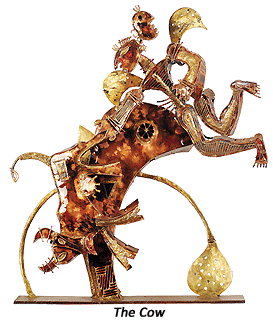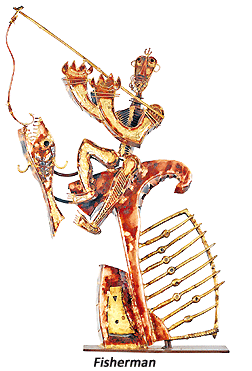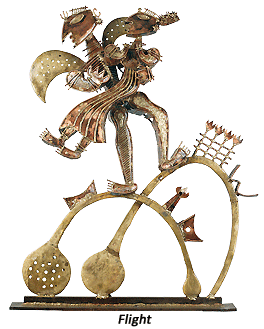- Prelude
- Editorial
- 'Public Sculptures are the Public's own Consciousness'
- Stimulating Thoughts
- Sculptural Traditions and Contemporary Art Practices
- Sculpting out a Third Dimension from Madhya Pradesh
- About Nostalgic Dragonflies and Homes in the Bags: Sculptural Snapshots from the North-East
- A Concise Chronicle of Bengal's Modern Sculpture
- Neo-sculptural Identity: Six Young Sculptors
- From Object to Experience: Notes on American Sculpture
- In the Domain of Drama Sculptures of S.Nandagopal
- Satish Gujral : Sculpting the Inner Form
- Transformation of Articulations: Mrinalini Mukherjee
- The Experiential Quotient in the Sculptures of Ravinder Reddy
- Shresta Rit Premnath A Passion for Structure
- The Anatomy of Melancholy: Sculptures of Rajesh P Subramanium
- A Crusader of/for Site Specific Public Art: Subodh Kerkar
- Installation Practices in and around Santiniketan
- A Wall is a Screen: A Promenade Film Street Performance
- Jaeger-LeCoultre An Overview
- Regency Style: Regency Furniture
- Designing the Streetscapes: Visual Elements of Pedestrian Corridors
- Sculpture Rules It All
- The Triumph of the Eternal
- Artist Index and Statistics- Anish Kapoor
- Auction Reports
- Musings from Chennai
- Art Bengaluru
- Art Events Kolkata: October-November 2010
- Mumbai Art Sighting
- An Evening of Interaction
- 6th Asian Museum Curators' Conference
- Swedish Art in India
- Couple of Difference : Recent sculptures of Karl Antao
- Previews
- In the News
- Sotheby's : Important Watches Geneva
ART news & views
In the Domain of Drama Sculptures of S.Nandagopal
Volume: 3 Issue No: 11 Month: 12 Year: 2010
by Koeli Mukherjee Ghose
S. Nandagopal, born in Bangalore in 1946, lives and works in Cholamandal artist's village in Chennai. He graduated with a degree in physics from Loyola College Madras in 1966, and received a first class Diploma in Fine Arts from the Government College of Arts and Crafts, Madras in 1971.
In Nandagopal's works the convergence of disparate receptivity towards the theories of western art and the practice of working with eastern traditional sensibilities make his sculptures effervescent and coded; this is discerned by the art historians and scholars.  His ability to integrate linearity and flatness in his sculptures adds a painterly dimension to his work and imbues it with graphic quality. The forms he creates are caught with an element of vitality of the primeval wall paintings. In his earlier works, the artist was inspired by the theory of "asymmetry in symmetry" introduced by Josef James in the late 1960s. Josef's concept was inspirational for almost all artists connected with the Madras Movement, but Nandagopal's appropriation of this principle was fruitful while he was working on "Ritual Image" in 1970 (which won the grand prize at the Fourth International Triennale, New Delhi). By extending the length of the sculpture as much as it would take before toppling over, he successfully reinforced the element of asymmetry in his sculptures; this was closely followed by a series of pieces where lyricism, graphic details and elements borrowed from the craft tradition, began to inform his works.
His ability to integrate linearity and flatness in his sculptures adds a painterly dimension to his work and imbues it with graphic quality. The forms he creates are caught with an element of vitality of the primeval wall paintings. In his earlier works, the artist was inspired by the theory of "asymmetry in symmetry" introduced by Josef James in the late 1960s. Josef's concept was inspirational for almost all artists connected with the Madras Movement, but Nandagopal's appropriation of this principle was fruitful while he was working on "Ritual Image" in 1970 (which won the grand prize at the Fourth International Triennale, New Delhi). By extending the length of the sculpture as much as it would take before toppling over, he successfully reinforced the element of asymmetry in his sculptures; this was closely followed by a series of pieces where lyricism, graphic details and elements borrowed from the craft tradition, began to inform his works.
The four decades of his practice have generated in him a concentrated sensibility of the traditional Indian Bard, narrating and unraveling simultaneously. Nandagopal infuses the spoken word in the title that he designates each work with like a whisper. That is where the spoken word begins and takes a plunge, in the interplay of linear and rhythmic forms, creating well-defined characters - specific though performing multiple roles, in being the hero and simultaneously changing and becoming part of all other forms that construe the total sculptural image.
This cyclic notion of feeding a tale into the form introduces an element of animation to the form. In the real sense the sculpture does not move from its place, but in the mind of the viewer, forms and elements from the composition continually have an effect, in stirring each other. Hence the forms are always in the state of becoming. Each element has the potential energy to burst out of the composition. The kinetic force prevalent in the lines and forms are reminiscent of the Kandiskian sensibility that is expressed in his essay on the point and line to plane; “The line is the product of a force. It is a point on which a living force has been applied in a given direction, the force applied on the pencil or on the paint brush by the hand of the artist.  The produced linear forms can be of several types: a straight line, which results from a unique force applied in a single direction, an angular line, which results from the alternation of two forces with different directions, or a curved or wave-like line produced by the effect of two forces acting simultaneously. A plane can be obtained by condensation, from a line rotated around one of its ends.” said Wassily Kandinsky.
The produced linear forms can be of several types: a straight line, which results from a unique force applied in a single direction, an angular line, which results from the alternation of two forces with different directions, or a curved or wave-like line produced by the effect of two forces acting simultaneously. A plane can be obtained by condensation, from a line rotated around one of its ends.” said Wassily Kandinsky.
What Michele Henry wrote in the essay, “Seeing the Invisible, on Kandinsky”, can be imagined and appropriated as integral to Nandagopal's work as well. "Kandinsky was fascinated by the expressive power of linear forms. Lyricism is the pathos of a force whose triumphant effort enters into action and encounters no obstacle. Because the straight line results from the initiative of a single, unopposed force, its domain is that of the lyric. When two forces are present and thus enter in conflict, as this is the case with the curve or the zigzag line, we are in domain of drama." (Michel Henry, Seeing the Invisible, on Kandinsky, p. 52).
The linear forces placed in opposition to each other in Nandagopal's sculptural compositions reinstate that we are now in the domain of drama.
The Vastu sutra in the Upanishads emphasizes on the line and states that it is the line that conveys the bhava which comprehends the image; the lines are the truth and the lines are the cause of form, and the line is the support of the composition. While the rekha or the line displays the emotional character of the image, the bindu or the focal point is the source of the image's artistic energy. These are however the machineries to arrive at a pictorial formation which completes itself in the mind of the creator as Nandagopal brings to context the visionary experience.
These are however the machineries to arrive at a pictorial formation which completes itself in the mind of the creator as Nandagopal brings to context the visionary experience.
Myths and legends add strength and magnificence to his forms but certainly their references are kept alive by a sense of respect and faith in his cultural heritage. Nandagopal deliberates, “When I look at a sculpture, I do not really see it as religious or secular. I am not aware of this distinction as I plan my sculpture. What are true to life are simultaneously one and the other. In this sense, my work is more to do with religiosity, which can occur even when confronted with a powerful Western abstract expressionist work of art”.
Nandagopal reflects that traditionally classical art in India has been related deeply to religion. As the kings assigned the building of temples to master craftsmen, they were the bastion of this tradition. “The craftsmen were both designers and sculptors. These assignments brought master sculptors to conceive and execute powerful making of the sculptures at Mahabalipuram, Ellora, Pattadakkal, Konarak and other temples in India. By about the fifth century A.D., in Gupta sculptures, the Indian sculptures had abstracted the image out of individuality of the human subject and arrived at the figure instead of fashioning the image as if it might be that of some individual person. With the figures, they could abstract from widely ranging spheres and give appearances to rarer natures and states. Traditional Indian sculpture has been distinguished by this particular method of abstraction”, articulates the sculptor.
Perspective is an internal consideration to define the spirit of the idea or the form with reference to traditional Indian sculptures, unlike the notion of perspective that is considered to be an external aspect in the Western art,  expressed mostly through foreshortening in sculptures. “Shilpa Shastra, the ancient Indian treatise on sculpture, provided yojanas or coded measurements for the various parts of the body. Accordingly an intellectual, when portrayed, would be represented with a broad forehead; a great man by his hands extended well below his knees this does not mean that, by knowing these measurements, anyone could draw a figure; in the hands of a great artist, the code helped create a masterpiece.” To explicate further Nandagopal mentions how Rodin's acknowledgement of the Nataraja image, as the greatest creation by the human hand, generated in him a sense of curiosity that drove him to carefully examine the Chola piece; he noted the palm, that was turned downwards, was larger than the other facing upward. This he reflected was a deliberate effort by the traditional sculptor to render perspective, not by varying depth, as in the West, but by varying size.
expressed mostly through foreshortening in sculptures. “Shilpa Shastra, the ancient Indian treatise on sculpture, provided yojanas or coded measurements for the various parts of the body. Accordingly an intellectual, when portrayed, would be represented with a broad forehead; a great man by his hands extended well below his knees this does not mean that, by knowing these measurements, anyone could draw a figure; in the hands of a great artist, the code helped create a masterpiece.” To explicate further Nandagopal mentions how Rodin's acknowledgement of the Nataraja image, as the greatest creation by the human hand, generated in him a sense of curiosity that drove him to carefully examine the Chola piece; he noted the palm, that was turned downwards, was larger than the other facing upward. This he reflected was a deliberate effort by the traditional sculptor to render perspective, not by varying depth, as in the West, but by varying size.
Nandagopal begins his sculptures by enlarging his drawings to the size that he wants his sculptures to be, he then transfers the drawing on boxboards, bending them to get an idea of the depth of the sculptures, the boards are then taped and put up to visualize how the sculpture would look when transferred in the metal. The drawing then is transferred on sheets of copper or brass and cut by the process of annealing. The metal is heated in the furnace to a red hot condition, it softens when it is cooled and then it is ready to be worked with, as it bends more easily. After it has been welded properly with an Oxyacetylene flame, the sculpture is then cleaned with nitric acid and electrically buffed to get an equally spreading shine. As the last step the sculpture is sprayed with polyurethane lacquer for preserving the Patina. He also retains the natural blackening of the metal as a result of being heated. The blackening creates a sense of painterly depth in defining forms. Various textures on his sculptural panels, such as cross hatching, triangles, arrows projecting outwards from the edge of the sculptures, punched holes, and spiral shapes create special points of interest in building the amazing tale within the elaborate sculptural arrangement that is massive and yet gives the impression to be light due to its frontality and equally spreading shimmer.
The element that defines contemporanaeity keeps changing in contemporary Indian Art, but surely it is not to be perceived as a cosmetic mannerism. The stance that the artist declares has to be taken into consideration.  Nandagopal has incorporated his experience in working as a painter, a jewellery maker, a ceramist, and a metalworker, in his sculptures; he is uninhibited in his approach towards the assimilation of traditional crafts of Indian origin. His involvement and transference of the experience of learning from the master craftsmen in the art school, is reflected in what he says “I have always sensed in me the liveliness of a drawing, the feel of colour, the genius of design and the preciousness of material, I work with. This understanding of the “preciousness of the material” has removed stringency of compartmentalization and conferred sensibilities to make everything work in his favour. Thus to him the legacy of craft does not mean a light-hearted repetitiveness; rather the skill of crafting translates itself to the rudimentary strength. If an artist of Indian origin is free to imbibe and appropriate elements from Western art practices in his work, the fact that he would respond to the sensibilities of his own traditions, be it that of craft, is quite natural. Tales emerging from his soil navigate his environment and daily incidents. Thus understanding the preciousness of one's tradition, holding on to it so that it does not faze, is a contemporary stance as opposed to being swayed by general consensus that makes us alienated and unresponsive to our own language.
Nandagopal has incorporated his experience in working as a painter, a jewellery maker, a ceramist, and a metalworker, in his sculptures; he is uninhibited in his approach towards the assimilation of traditional crafts of Indian origin. His involvement and transference of the experience of learning from the master craftsmen in the art school, is reflected in what he says “I have always sensed in me the liveliness of a drawing, the feel of colour, the genius of design and the preciousness of material, I work with. This understanding of the “preciousness of the material” has removed stringency of compartmentalization and conferred sensibilities to make everything work in his favour. Thus to him the legacy of craft does not mean a light-hearted repetitiveness; rather the skill of crafting translates itself to the rudimentary strength. If an artist of Indian origin is free to imbibe and appropriate elements from Western art practices in his work, the fact that he would respond to the sensibilities of his own traditions, be it that of craft, is quite natural. Tales emerging from his soil navigate his environment and daily incidents. Thus understanding the preciousness of one's tradition, holding on to it so that it does not faze, is a contemporary stance as opposed to being swayed by general consensus that makes us alienated and unresponsive to our own language.
The drama is enhanced by the massive sculptures of a dancing goat and a man merging in the same structure; their moving in opposite directions creates a dual focal interest from left to right and vice versa. The arrow, the sickle and the sharp tools, take control of, and at the same time, mislays their belligerence, to a sense of rhythm and harmony. The air around the sculpture is made to be a part of the sculptural surface, and in that space, the cows, people, insects and trees are in the process of crawling or leaping about with an ultimate sense of freedom. The bending of trees to become hillock-like forms and the fisherman on a tilted mound, and the predator ready to torture and engulf are legendary, and yet telling a new tale, culled out from the three rasas, or the essential mental state of veeram, bhayanakam and adbhutam.